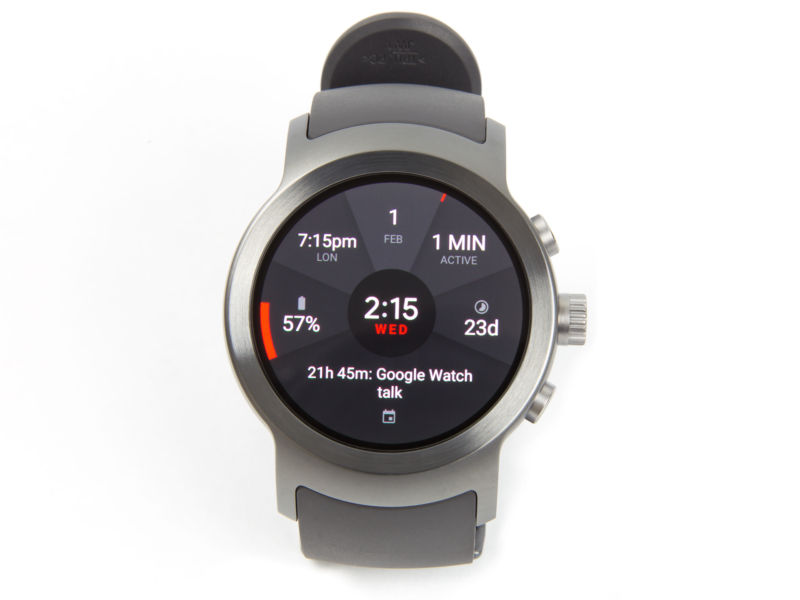
Ars Technica would like to wish a very special second birthday to the Qualcomm Snapdragon Wear 2100 SoC. While most flagship SoCs have a life cycle of about one year on the top of the market, over the weekend the Wear 2100 will celebrate two years as the least awful smartwatch SoC you can use in an Android Wear device. It's positively ancient at this point.
Seriously though, Qualcomm has seemingly abandoned the smartwatch market. The Wear 2100 SoC was announced in February 2016, Qualcomm skipped out on an upgrade for February 2017, and it doesn't seem like we're getting a new smartwatch chip any time soon.
In a healthy SoC market, this would be fine. Qualcomm would ignore the smartwatch SoC market, make very little money, and all the Android Wear OEMs would buy their SoCs from a chip vendor that was addressing smartwatch demand with a quality chip. The problem is, the SoC market isn't healthy at all. Qualcomm has a monopoly on smartwatch chips and doesn't seem interested in making any smartwatch chips. For companies like Google, LG, Huawei, Motorola, and Asus, it is absolutely crippling. There are literally zero other options in a reasonable price range (although we'd like to give a shoutout to the $1,600 Intel Atom-equipped Tag Heuer Connected Modular 45), so companies either keep shipping two-year-old Qualcomm chips or stop building smartwatches.
Android Wear is not a perfect smartwatch operating system, but the primary problem with Android Wear watches is the hardware, like size, design (which is closely related to size), speed, and battery life. All of these are primarily influenced by the SoC, and there hasn't been a new option for OEMs since 2016. There are only so many ways you can wrap a screen, battery, and body around an SoC, so Android smartwatch hardware has totally stagnated.To make matters worse, the Wear 2100 wasn't even a good chip when it was new. The chip is built with a 28nm process, which was old and busted even in 2016. Qualcomm's flagship smartphone SoC at the time was the Snapdragon 820, which used a much better 14nm process. To find a flagship 28nm smartphone chip, you'd have to go back in time to the Snapdragon 801/800. That's right, 28nm was state-of-the-art smartphone technology in 2013. A smaller transistor manufacturing process will lead to a chip that is cooler, smaller, and more battery-efficient. While these attributes matter in smartphones, they matter far more in smartwatches, and Qualcomm has never put real effort into its smartwatch chips.
From a short-sighted numbers perspective, Qualcomm's behavior makes sense. Smartphones sell far more than smartwatches, so Qualcomm's bottom line in the short term is better if it dedicates its efforts to smartphones. But with the launch of Android Wear, Google, Qualcomm, and the Android OEMs were building a new "Android smartwatch" market category from scratch. It was always going to take some risks and investment from everyone involved, but the upside would be a larger market for everyone. With Qualcomm never putting in a serious effort to produce a good smartwatch chip, the Android Wear market struggled out of the gate, and today it seems dead.
Meanwhile, Samsung and Apple have taken over the smartwatch market. Apple sells Apple Watches to iOS users, while Samsung makes smartwatches based on its own Tizen OS that work with Android and iOS devices. Both companies have managed to avoid being sabotaged by Qualcomm because both have their own in-house SoC teams. Apple and Samsung devices get a new SoC every year, delivering faster performance and better battery life, while Qualcomm and Android Wear stand still. As a result, Apple is at the top of the smartwatch market, and even Samsung Tizen watches have claimed second place and overtaken the combined 20 or so companies making Android Wear watches.Since no other SoC company has taken up arms against Qualcomm at the high end of the market, the only solution for OEMs looking to protect themselves is to build their own SoC program. As mentioned, Apple and Samsung are in the best position. Huawei is next in line with its "Hisilicon" SoC division, although it has only produced smartphone SoCs. Google seems to be slowly building an SoC division, including hiring a key Apple chip architect for the position of "Lead SoC Architect." So far we've only seen a single machine-learning co-processor from the company, the Pixel Visual Core, which shipped in the Pixel 2 and Pixel 2 XL, but it seems like a main application processor will someday appear in a Google smartphone.
In the meantime, Android smartwatches continue to be thick, slow, power-hungry devices that can't keep up with the competition. Take a look at some iPhone benchmarks and you'll find Qualcomm's smartphone chip isn't doing that great against the competition, either. Qualcomm killed the Android smartwatch with a combination of monopoly power and apathy. Things will probably get even worse if Broadcom's campaign to purchase Qualcomm is successful.
reader comments
230